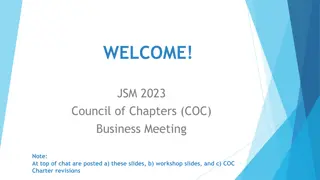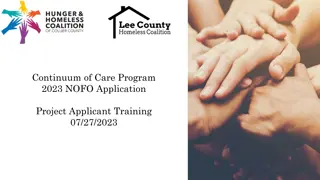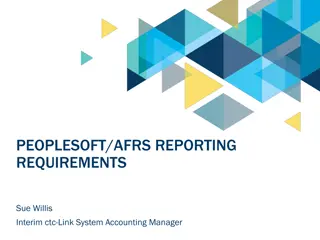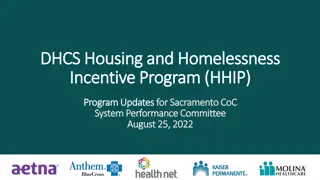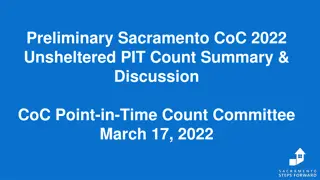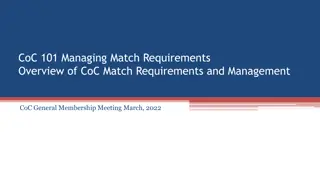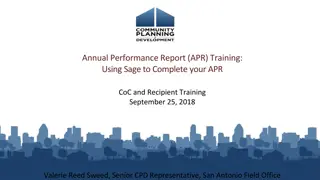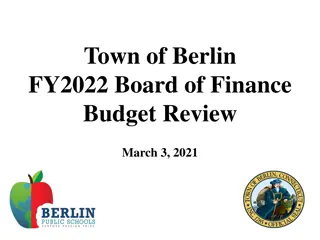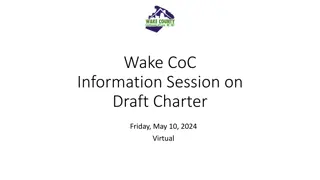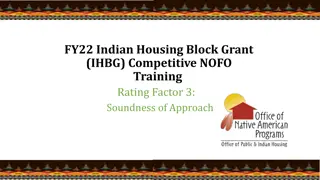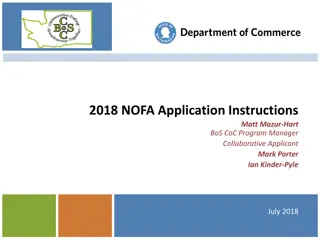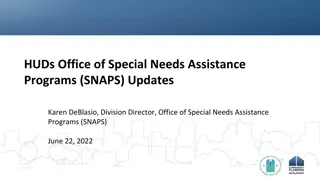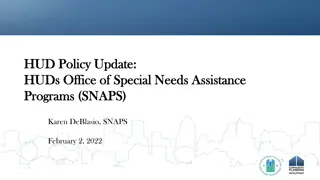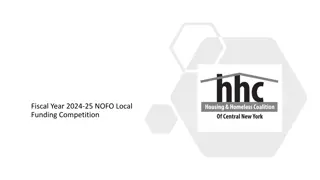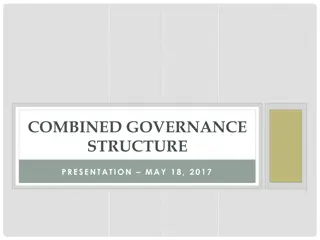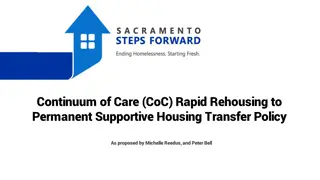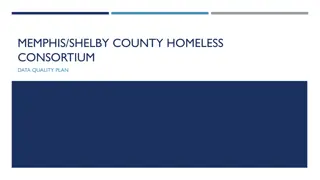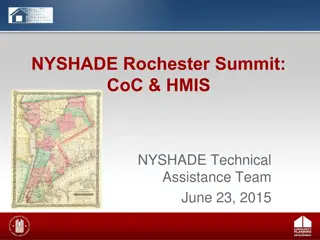
Funding Opportunity for DV and CoC Projects
Enhance your efforts to end homelessness with new funding for Domestic Violence (DV) and Continuum of Care (CoC) projects. Join the webinar to learn about available funding, project requirements, and how to apply for grants to support survivors of violence and homelessness. Take advantage of this opportunity to make a positive impact in your community.
Download Presentation

Please find below an Image/Link to download the presentation.
The content on the website is provided AS IS for your information and personal use only. It may not be sold, licensed, or shared on other websites without obtaining consent from the author. If you encounter any issues during the download, it is possible that the publisher has removed the file from their server.
You are allowed to download the files provided on this website for personal or commercial use, subject to the condition that they are used lawfully. All files are the property of their respective owners.
The content on the website is provided AS IS for your information and personal use only. It may not be sold, licensed, or shared on other websites without obtaining consent from the author.
E N D
Presentation Transcript
Continuum of Care (CoC) Notice of Funding Opportunity ( NOFO ) Webinar Wednesday, August 17 9-10:30 New funding for DV Bonus & CoC Bonus & Renewal Funding
Nashville CoC Bonus $343,650 Domestic Violence (DV) Bonus funding $414,814 Renewal projects $6,872,991 Competitive! FUNDING AVAILABLE- Nationwide $2,794,000,000 available
CoC Projects Funded in FY2021 CoC FY2021 Funding to Nashville Field Office: Knoxville CoC Number: CoC Name: CA Name: CoC's ARD (Estimated): TN-504 Nashville-Davidson County CoC Metropolitan Development & Housing Agency $6,872,991 Applicant and Project Information Current Budget Line Item Amounts Project Component Assistance Services Costs Rental Supportive Operating Applicant Name Project Name Leasing HMIS Admin Total ARA Metropolitan Social Services Metro Social Services: HMIS Renewal FY2021 Urban Housing Solutions, Inc. Urban Housing Solutions Homeless Recovery Program FY2021 The Mary Parrish Center Renewal The Mary Parrish Center TH FY2021 Metropolitan Development & Housing Agency MDHA Shelter Plus Care Consolidated Renewal 2021 Campus for Human Development Omega COC 2021 Room In The Inn Safe Haven Family Shelter Safe Haven RRH Consolidated 2021 Metropolitan Social Services Metro Social Services: Coordinated Entry FY2021 The Salvation Army, a Georgia Corporation The Salvation Army Nash Joint TH/RRH 2021 The Mary Parrish Center Renewal The Mary Parrish Center Joint TH and PH-RRH FY2021 The Mary Parrish Center Renewal The Mary Parrish Center SSO-CE FY2021 The Mary Parrish Center Renewal The Mary Parrish Center RRH FY2021 The Salvation Army, a Georgia Corporation Lif Nav Rapid Rehousing 2021 Oasis Center, Inc. YHDP Rapid Rehousing Project for Young Adults Oasis Center, Inc. YHDP Diversion Project for Youth and Young Adults Park Center, Inc. Nashville Housing First Collective Safe Haven Family Shelter Safe Haven DV Bonus 2021 HMIS PH TH PH PH PH SSO $0 $0 $0 $0 $0 $0 $0 $0 $0 $0 $0 $0 $0 $0 $0 $0 $0 $0 $0 $138,961 $0 $0 $0 $0 $0 $0 $0 $0 $0 $0 $0 $1,000 $1,000 $0 $0 $2,547 $16,677 $0 $97,000 $1,994 $1,860 $11,520 $10,000 $5,000 $5,000 $1,434 $0 $82,933 $44,730 $6,422 $0 $141,508 $640,153 $23,688 $2,257,084 $45,622 $250,116 $128,000 $226,616 $225,916 $103,120 $90,150 $62,665 $1,217,629 $639,000 $115,467 $706,257 $180,650 $4,488 $0 $0 $5,640 $116,480 $58,197 $98,120 $98,120 $0 $33,541 $587,682 $566,247 $0 $258,189 $442,826 $19,200 $0 $43,628 $0 $0 $77,059 $0 $0 $0 $0 $12,902 $27,023 $0 $0 $2,160,084 $0 $242,616 $0 $81,360 $122,796 $0 $88,716 $29,124 $533,112 $0 $0 $448,068 Joint TH & PH-RRH Joint TH & PH-RRH SSO PH PH PH SSO PH PH $109,045 $0
The purpose of this NOFO is to support existing effective efforts to end homelessness, and create new projects to serve and house chronic homeless persons or survivors of domestic violence, dating violence, sexual assault or stalking who qualify as homeless. CoCs must demonstrate a comprehensive, coordinated approach to reducing homelessness. The CoC s comprehensive approach should advance equity and demonstrate involvement of individuals with lived experience of homelessness in service delivery and decision making. The CoC s comprehensive approach should include partnership with health and housing agencies to leverage mainstream housing and healthcare resources. These partnerships should support the Housing First and public health principles defined by HUD.
HUD 9 Homeless Policy Priorities- FY2022 NOFO 1. Ending homelessness for all persons. Partner with housing, health care, and supportive services providers to expand housing options, such as permanent supportive housing, housing subsidies, and rapid rehousing. Use local data to determine highest needs and longest experiences, challenges faced by all subpopulations experiencing homelessness in the geographic area (e.g., veterans, youth, families, or those experiencing chronic homelessness) 2. Use a Housing First approach. Prioritize rapid placement and stabilization in permanent housing and do not have service participation requirements or preconditions. Engage landlords and property owners to identify an inventory of housing available for rapid rehousing and permanent supportive housing participants remove barriers to entry, and adopt client-centered service methods. Assess how well Housing First approach is being implemented. 3. Reducing Unsheltered Homelessness. In recent years, the number of people experiencing unsheltered homelessness has risen significantly; they have extremely high rates of physical and mental illness and substance use disorders. 4. Improving System Performance. Use system performance measures (e.g., average length of homeless episodes, rates of return to homelessness, rates of exit to permanent housing destinations) to determine how effectively they are serving people experiencing homelessness. Use CE to promote participant choice, coordinate homeless assistance and mainstream housing. Include cost- effectiveness, implement continuous quality improvement and other process improvement strategies. HUD recognized effects of COVID-19 on CoC performance and data quality and, in 2021, reduced the points available for rating factors related to system performance. This FY 2022 CoC NOFO significantly increases the points available for system performance rating factors. 5. Partnering with Housing, Health, and Service Agencies. Maximize the use of mainstream and other community-based resources: a. work closely with public and private healthcare organizations and assist program participants to obtain medical insurance to address healthcare needs. This includes developing close partnerships with public health agencies to analyze data and design approaches that reduce homelessness, improve the health of people experiencing homelessness, and prevent and address disease outbreaks, including HIV/AIDS. b. partner closely with Public Housing Agencies/state and local housing organizations to utilize CE, develop housing units, and provide housing subsidies to people experiencing homelessness/ help CoC Program participants exit permanent supportive housing through Housing Choice Vouchers and other available housing options. CoCs and PHAs should work together to target Emergency Housing Vouchers, HUD-VASH, Mainstream Vouchers, Family Unification Program Vouchers, and other housing voucher programs targeted to people experiencing homelessness. Coordinate with state/local housing agencies on new HOME program resources provided through the Homelessness Assistance and Supportive Services Program that was created through the American Rescue Plan; c. partner with local workforce development centers to improve employment opportunities
HUD 9 Homeless Policy Priorities- FY2022 NOFO 6. Racial Equity. In nearly every community, Black, Indigenous, and other people of color are substantially overrepresented in the homeless population. HUD is emphasizing system and program changes to address racial equity within CoCs. Responses to preventing and ending homelessness should address racial inequities to ensure successful outcomes for all persons experiencing homelessness using proven approaches, such as: developing a coordinated community response created in partnership with a racially diverse set of stakeholders and people experiencing homelessness and partnering with organizations with experience serving underserved populations. Review policies, procedures, and processes to identify barriers that result in racial disparities, and take steps to eliminate barriers to address disparities. 7. Improving Assistance to LGBTQ+ Individuals. Address the needs of LGBTQ. Ensure privacy, respect, safety, and access regardless of gender identity or sexual orientation & partner with organizations with expertise in serving LGBTQ+ populations. 8.Persons with Lived Experience. Include in the local planning process people who are currently experiencing or have formerly experienced homelessness to address homelessness. People with lived experience should determine how local policies may need to be revised and updated, to improve the effectiveness of homelessness assistance programs, including participating in planning and oversight activities and developing local competition processes. CoC leaders and stakeholders should also prioritize hiring people who have experienced homelessness in areas where their expertise is needed (e.g. peer outreach and support). 9. Increasing Affordable Housing Supply. The lack of affordable housing is the main driver of homelessness. CoCs play a critical role in educating local leaders and stakeholders about the importance of increasing the supply of affordable housing and the specific consequences of the continued lack of affordable housing. CoCs should be communicating with jurisdiction leaders, including the development of Consolidated Plans, about the harmful effects of the lack of affordable housing, and they should engage local leaders about steps such as zoning and land use reform that would increase the supply of affordable housing. This FY2022 CoC NOFO awards points to CoCs that take steps to engage local leaders about increasing affordable housing supply.
New Project Options (a) New Permanent Supportive Housing (PSH) projects must serve one of the following: (i) DedicatedPLUS; or (ii) persons experiencing chronic homelessness at the time they initially enroll in the project. (b) New Rapid Rehousing, Joint Transitional Housing/RRH, and SSO-CE projects may serve persons who qualify as homeless under paragraphs (1), (2), or (4) of 24 CFR 578.3. Additionally, these projects may serve persons who qualify as homeless under paragraph (3) of 24 CFR 578.3 if the CoC is approved to serve persons in paragraph (3). (c) New DV Bonus projects (RRH, Joint TH/PH-RRH, and SSO-CE) must serve survivors of domestic violence, dating violence, sexual assault, or stalking who qualify as homeless under paragraph (4) of 24 CFR 578.3.
PSH Provides indefinite leasing or rental assistance combined with supportive services for disabled persons experiencing homelessness so that they may live independently. For this NOFO, construction, renovation and acquisition are eligible. RRH- Housing search and relocation services & short- and medium-term rental assistance to move homeless persons and families (with or without a disability) as rapidly as possible into housing.
Eligible participants- New Permanent Supportive Housing Chronically Homeless -- As stated in HUD s Definition of Chronically Homeless final rule is: who: (a) A homeless individual with a disability, as defined in section 401(9) of the McKinney-Vento Homeless Assistance Act (42 U.S.C. 11360(9)), i. Lives in a place not meant for human habitation, a safe haven, or in an emergency shelter; and the last 3 years, as long as the combined occasions equal at least 12 months and each break in homelessness separating the occasions included at least 7 consecutive nights of not living as described in paragraph (a)(i). Stays in institutional care facilities for fewer than 90 days will not constitute as a break in homelessness, but rather such stays are included in the 12-month total, as long as the individual was living or residing in a place not meant for human habitation, a safe haven, or an emergency shelter immediately before entering an institutional care facility; ii. Has been homeless and living as described in paragraph (a)(i) continuously for at least 12 months or on at least four separate occasions in hospital, or other similar facility, for fewer than 90 days and met all of the criteria in paragraph (a) of this definition, before entering the facility; (b) An individual who has been residing in an institutional care facility, including a jail, substance abuse or mental health treatment facility, paragraph (a) or (b), including a family whose composition has fluctuated while the head of household has been homeless. (c) A family with an adult head of household (or if there is no adult in the family, a minor head of household) who meets all of the criteria in
Dedicated Plus (Chronic Lite) DedicatedPLUS - A DedicatedPLUS project is a permanent supportive housing (PH-PSH) project where 100% of the beds are dedicated to serve individuals, households with children, and unaccompanied youth that at intake are: (1) experiencing chronic homelessness (CH); OR (2) residing in a Transitional Housing (TH) project that will be eliminated and were chronically homeless when entered TH project; or (3) residing in Emergency Shelter or unsheltered location and had been enrolled in a PSH or RRH project (having met CH criteria upon entering) within the last year, but were unable to maintain housing placement; or (4) residing in TH funded by a Joint TH and Rapid Re-Housing (PH-RRH) component project and who were experiencing chronic homelessness prior to entering the project; or (5) residing in Emergency Shelter or unsheltered location for at least 12 months in the last three years, but have not done so on four separate occasions and the individual or head of household meets the definition of homeless individual with a disability ; or (6) receiving assistance through a Department of Veterans Affairs (VA)-funded homeless assistance program and met one of the above criteria at initial intake to the VA's homeless assistance system.
CoC & DV Bonus Projects 1 or > 1 project app ok for both- except only one DV-CE Nashville earns points if at least 1 new project commits 25% leverage for housing units & health care value. Both housing & health care can be in 1 project, can be in 2 separate new projects DV Bonus- applicant agency does not have to be DV provider
What HUD is Looking for in Community Responses - System Level Elements Leverage the expertise of people who have experienced homelessness Continuously advance best practices Streamline the delivery of assistance Advance equity in service design and delivery Utilize local data and measure outcomes
Coordinated Homeless Outreach What HUD is Looking for in Community Responses Health Care and Supportive Services Strategy to offer Low Threshold/Non- Congregate Shelter Program Components Housing First/Reduce Barriers to Housing Leverage Mainstream Housing and Engage Landlords
Eligible Project Types Permanent Housing- Permanent Supportive Housing (PSH) Provides indefinite leasing or rental assistance combined with supportive services for disabled persons experiencing homelessness so that they may live independently. For this NOFO, construction, renovation and acquisition are eligible. Permanent Housing- Rapid Rehousing (RRH) Housing search and relocation services & short- and medium-term rental assistance to move homeless persons and families (with or without a disability) as rapidly as possible into housing. Joint Transitional Housing TH/ Rapid Rehousing RRH (services/rental assistance for < 24 mo) Supportive Service Only (Coordinated Entry) HMIS CoC Planning will not be ranked
Eligible Activities Rental assistance Operating costs Acquisition, Rehabilitation, New construction Leasing Supportive Services in PSH or RRH HMIS Supportive Services Only- Coordinated Entry CoC Planning
Supportive Services eligible Supportive Services eligible with with PSH & RRH PSH & RRH Eligible Support Services are: Life skills training Annual Assessment of Services Mental health services Moving costs (1-time) Outpatient health services Case management Outreach services Childcare Substance abuse treatment services Education services Transportation Employment assistance and job training Utility deposits Food Housing search and counseling services Legal services
All CoC funded projects are required to comply with all federal rules and regulations listed in the NOFO, as well as participate in the CoC. Requirements include (but are not limited to): Provide the following documentation to HUD via agency s e- snaps application to determine eligibility: HUD form 50070, HUD form 2880, Agency Code of Conduct, SAM Registration, and UEI (Unique Entity Identifier) number. Other documents may be required. Threshold Requirements of HUD CoC Funded Projects Utilize Housing First principles in the implementation of the project. Participate in the CoC s Coordinated Entry, follow all related policies and procedures, regular program-level attendance at Care Coordination Meetings. Participate in Homeless Management Information System (HMIS) & comply with all related policies and federal mandates Participate in the CoC as an active member.
HUD System Performance Measures This FY 2022 CoC NOFO significantly increases the points available for system performance rating factors. 1. Reduce the length of time persons remain homeless 2. Reduce returns to homelessness 3. Reduce the number of homeless persons 4. Access jobs and income growth for homeless persons in CoC Program-funded projects 5. Reduce the number of persons who become homeless for the first time 6. Successful housing placement
Interested organizations must complete the NOFO local competition application. The application forms will be emailed to the listserv and posted on MDHA s website (go to Community Development Continuum of Care CoC Competition Materials). Applications must be submitted in PDF format to Suzie Tolmie, Homeless Coordinator by email: stolmie@Nashville-MDHA.org HUD encourages organizations and entities who have never received CoC funding to submit an application. The Metropolitan Nashville-Davidson County Continuum of Care Application Process
Project applications will be reviewed by the CoC Performance Evaluation Committee (PEC) and prioritized during its Rank and Review process on Monday, September 12th. CoC Ranking
NOFO Released by HUD August 1 RFP Notice Released August 11 2022 Regular NOFO Timeline NOFO webinar August 17 Application and Scoring Matrix Released August 17 Local Applications Due August 29 Rank and Review Period Aug 29- Sept 12 Scores Released September 14 Deadline for Scoring Appeals September 16 Collaborative Application and Project Applications Posted September 28 CoC Submits Final Collaborative Application in E-Snaps September 29
Questions, Comments for NEW PROJECTS End of information for NEW PROJECTS & on to Renewal Project Section
Renewal Projects YHDP- not ranked FY2021 New Projects (Safe Haven Family Shelter & Park Center)- under Grant Agreement? Detailed Instructions now Available Separate Detailed Instructions specifically for YHDP renewals E-snaps- Before accessing and completing a project application, access & update the Project Applicant Profile; then Register for Funding Opp, access project app Questions

